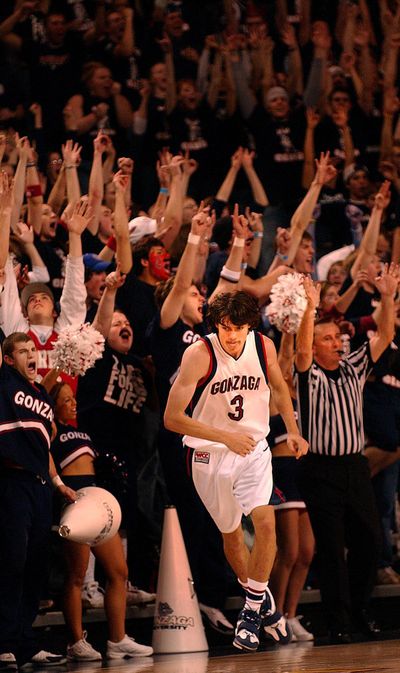Adam Morrison steps into spotlight as No. 5 Gonzaga beats Stanford with College GameDay in town

Put Adam Morrison under bright lights on a big stage, and he usually comes up with a performance to rival his surroundings.
Such was the case again on Saturday when Gonzaga’s junior scoring sensation ambled confidently onto perhaps the biggest stage he has occupied all year and calmly dropped in 34 points to help the fifth-ranked Bulldogs turn back Stanford 80-76.
Morrison, a 6-foot-8 shooting guard, made 10 of 18 field goals – including 4 of 9 3-pointers – and scored 13 of GU’s last 14 points to cap another splendid performance that played out in front of a national television audience and a jazzed crowd of 6,000 that packed into the McCarthey Athletic Center, which had earlier served as the headquarters for ESPN’s College GameDay broadcast.
The non-conference win was the 11th in a row for the Zags (20-3), who also got 24 points and a game-high eight rebounds from senior center J.P. Batista, and raised their nation’s-longest home winning streak to 36.
“I don’t know what to say about Adam’s performance,” Bulldogs coach Mark Few said afterward. “I think it’s sad that we have come to expect those types of games from him every night, and wonder what’s wrong when he doesn’t deliver.
“He made some big plays, but he always seems to play big in big games.”
Morrison struggled at times to find open shots against Stanford’s extended zone defense. But he made every big one he took down the stretch, to reach the 30-point mark for the 10th time this season.
“Stanford did a good job of limiting my touches,” Morrison said. “In that zone, they were playing me real high and not letting me get the good looks. But come crunch time, I’m going to do whatever it takes to win.”
The Cardinal (12-9), a perennial Pacific-10 Conference power, used some torrid shooting to forge 43-38 halftime lead, and led 61-56 with 8:48 remaining. But the Bulldogs responded with an 11-3 run that put them ahead for good.
Sean Mallon scored six of his eight points during GU’s run and then turned things over to Morrison, who hit several difficult shots – including a baseline jump hook over three Cardinal defenders – in the final minutes.
Stanford, which got 17 points from senior point guard Chris Hernandez, shot 58.6 percent (17 of 29) in the first half but cooled considerably after intermission when the Zags turned up the defensive pressure.
“I think we played too passive in the first half,” Few said. “Our team was caught up in the excitement of the game and everything that has been going on this week.”
Morrison, too, addressed his team’s lack of defensive resolve in the opening 20 minutes and said it was a halftime attitude adjustment that turned things around.
“You can’t have a team shoot 60 percent, especially not on your home floor,” he said. “There was nothing (we did) strategy-wise. We just needed to get stops.
“It’s a good sign for our team that we can actually buckle down and get some stops.”
It helped, as well, that Stanford made only 15 of 24 free throws.
“We shot, what, 62 percent from the free-throw line?” asked Hernandez, who sat for almost 8 minutes of the second half after picking up his fourth foul with 13:34 remaining. “If you’re going to come into the No. 5 team in the nation, on to their home court, you’re going to have to play flawless, and we didn’t have a flawless game. That’s why we didn’t win.”
Cardinal coach Trent Johnson was also disappointed with the way his team defended in the first half.
“I thought the first half was our best offensive production and execution at the start of a game this year,” he said. “But defensively, we were bad. They ran out on us in transition. This (Gonzaga) team is really skilled, but their speed and quickness is nothing like UCLA and Oregon in terms of transition, so that was disappointing.”